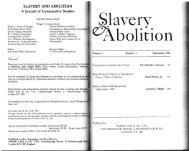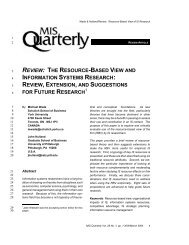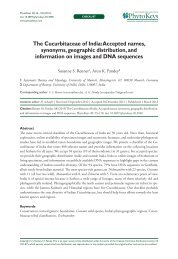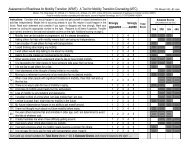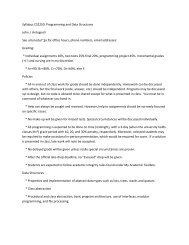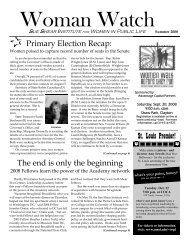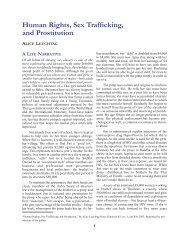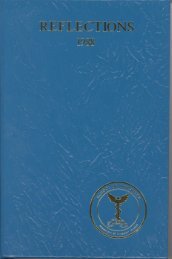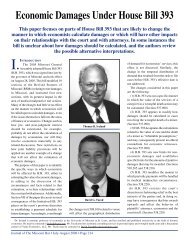The Price of Illicit Drugs: 1981 through the - The White House
The Price of Illicit Drugs: 1981 through the - The White House
The Price of Illicit Drugs: 1981 through the - The White House
Create successful ePaper yourself
Turn your PDF publications into a flip-book with our unique Google optimized e-Paper software.
transit zone programs almost certainly explain high wholesale prices. Although <strong>the</strong> wholesale price is only<br />
a fraction <strong>of</strong> <strong>the</strong> retail price (closer to $225,000 per pure kilogram), $25,000 is not insignificant. Moreover,<br />
this report shows that domestic dealers markup <strong>the</strong> wholesale price as <strong>the</strong>y resell to <strong>the</strong>ir customers,<br />
accounting for some <strong>of</strong> <strong>the</strong> $200,000 difference between retail and wholesale prices. <strong>The</strong> size <strong>of</strong> that<br />
markup – and hence <strong>the</strong> relative effectiveness <strong>of</strong> interdiction and domestic law enforcement – is <strong>the</strong><br />
principal issue <strong>of</strong> contention between those who say that interdiction is ineffective (because <strong>the</strong> markup is<br />
small) and those who say that interdiction is effective (because <strong>the</strong> markup is large). Estimates <strong>of</strong> <strong>the</strong> size<br />
<strong>of</strong> <strong>the</strong> price markup seem essential for assessing public policy.<br />
Continuing with <strong>the</strong> cocaine illustration, <strong>the</strong> drug might pass <strong>through</strong> several distribution levels, where <strong>the</strong><br />
principal value added is to repackage <strong>the</strong> cocaine into smaller lots. (Cocaine typically gets transformed into<br />
crack at <strong>the</strong> lowest distribution levels, but that process is also inexpensive.) Absent law enforcement, <strong>the</strong>n,<br />
<strong>the</strong> cost <strong>of</strong> moving a kilogram <strong>of</strong> cocaine from <strong>the</strong> wholesale level to <strong>the</strong> retail level would seem to be<br />
much less than $200,000 – probably closer to <strong>the</strong> cost <strong>of</strong> marketing aspirin. Thus, much <strong>of</strong> <strong>the</strong> $200,000<br />
that does not result from a markup <strong>of</strong> wholesale price is presumably a consequence <strong>of</strong> domestic law<br />
enforcement. 4 This is a second way that illicit drug prices are a reflection <strong>of</strong> anti-drug programs.<br />
As noted, supply-based programs can only carry <strong>the</strong> Nation so far toward achieving its targets for reducing<br />
illicit drug use. <strong>The</strong> larger part has to be played by programs that inhibit youth from experimenting with<br />
drugs, encourage moderate users to stop recreational use, and provide treatment and perhaps coercion for<br />
those habituated to illicit substances. Never<strong>the</strong>less, supply-side programs can cause higher drug prices, and<br />
those higher drug prices can be an important complement to demand-based programs. As prices increase,<br />
some drug users would choose to reduce <strong>the</strong>ir consumption. <strong>The</strong>y may even choose to quit using drugs, at<br />
least so long as prices remain high. Several researchers report evidence that drug users – even hardcore<br />
users – respond to higher prices by quitting or using a lower level <strong>of</strong> drugs. 5 Additional evidence is<br />
4 Domestic law enforcement operates on drug prices in three ways. First, domestic law enforcement seizes some <strong>of</strong><br />
<strong>the</strong> substance, <strong>the</strong>reby reducing its supply, or at least increasing <strong>the</strong> cost <strong>of</strong> selling <strong>the</strong> product. Second, law<br />
enforcement imposes substantial risks that dealers will be captured and incarcerated. Third, because drug dealing<br />
is outlawed, contracts between buyers and sellers are unenforceable at law, and violence <strong>of</strong>ten substitutes as a<br />
means <strong>of</strong> enforcing deals. Dealers would seem to charge higher prices to compensate for <strong>the</strong>se substantial risks.<br />
5 Caulkins, J. “Estimating Elasticities <strong>of</strong> Demand for Cocaine and Heroin with DUF Data,” working paper, Carnegie<br />
Mellon University, August 1995. Chaloupka, F, Grossman, M. and Tauras, J. “<strong>The</strong> Demand for Cocaine and<br />
Marijuana by Youth,” NBER working paper, No. 6411, 1998. Grossman, M., Chaloupka, F. and Brown, C.<br />
“<strong>The</strong> Demand for Cocaine by Young Adults: A Rational Addiction Approach,” NBER working paper, No. 5713,<br />
1996. Saffer, H. and Chaloupka, F. “<strong>The</strong> Demand for <strong>Illicit</strong> <strong>Drugs</strong>,” NBER working paper, No. 5238, 1995.90<br />
2





